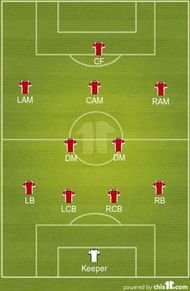Let us now take a look at a system that has been heavily popularized over the past few years, the 4-2-3-1. If you were to pinpoint when exactly the current variation of this system came back into the fore, one date, in particular, would be very relevant.
November 29, 2010.
Venue: Camp Nou.
Jose Mourinho’s Real Madrid were on the wrong end of a 5-0 hiding by a rampant Barcelona side. That fateful day, Mourinho knew he’d got his tactics wrong by playing Xabi Alonso in the deepest lying midfield role with no other protection. Messi’s drifts towards him presented Alonso with a dilemma about whether to drop goalside and give Barca a free run in midfield or let him go free and force one of the centre-backs out, exposing the defence.
Also read: Tactical systems explained: 4-3-3
But that would be the last time Mourinho would make such a mistake. On their next meeting he tweaked the system to introduce a proper two-man pivot in midfield thereby leading the 4-2-3-1 becoming his go-to system, and one he still uses quite often to this day.
Now, it seems as though every top-tier club has employed this as their system of choice at some point in time.
Strengths
The system works so well because passing the ball through triangles is often more effective than passing the ball in straight lines. The position of the central midfield pair in relation to the advanced three is set up such that it generates options. This is one of the main benefits over other traditional ‘flat’ systems such as the 4-4-2, which offers only ‘straight’ or ‘lateral’ play.
It also gives the added advantage of almost never being overrun in midfield. This formation offers tactical flexibility in terms of the advanced players being able to drop back into central areas as required. Having a greater number of potential attacking players would also mean these players can drop into the midfield role without having to worry about the possible loss of an offensive threat should an opportunity present itself.
Also read: Tactical systems explained: 4-4-2
Strikers who can play the role of ‘lone’ centre-forward well enough tend to thrive in this system due to so many players being available to pass the ball forwards; chances are created aplenty.
Weaknesses
One of the possible weaknesses of this system is the physical demand it places on its players. Teams that like implementing this system prefer starting attacks from deep midfield (think Ilkay Gundogan for Dortmund or Bastian Schweinsteiger in that CL winning Bayern Munich team of 2013-14). This is to generate misdirection and create confusion throughout a defence.
Thus the onus is on the attacking players to play with a tempo that is high enough to move from one end of the pitch to the other without allowing the opposition’s midfield and full-backs to move back into position.
A great example of when this didn’t work as intended was when Klopp tried to implement the same system that had brought him so much success in Dortmund, in Liverpool. The centre-forward at his disposal, Christian Benteke simply couldn’t play at the tempo Klopp demanded of him, leading to attacks constantly breaking down around him.
It would also be apt to remember, the year before, the physical strain of playing the system year in, year out (though not all on its own) had led to Klopp’s Dortmund experience one of their worst ever starts to a season; languishing in the relegation zone in December.
There is also a lot of responsibility on the wide attacking players to drop back with speed into defense when the opposition manages to pass out of the ball from defence.
Conclusion
The potential use of the passing triangles to work through flat midfields can lay waste to a team playing in a poorly executed 4-4-2. It also holds true the other way around; a flat midfield will find it very hard to break through the structure offered by the 4-2-3-1.
It is, however, a system that demands a high degree of tactical responsibility from its players. Every player must fulfill his role reasonably well. It is a system that focuses on the team as a whole rather than one that relies on the individual brilliance of one.
More Football news, transfer rumours, analysis and features at Sportskeeda.com


